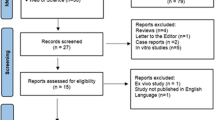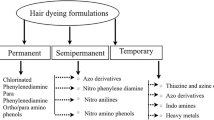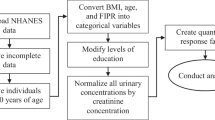Abstract
Objective
We compared, updated, and expanded the analyses of two previous meta-analyses of personal hair dye exposure and bladder cancer, and briefly discussed the biological plausibility of a systemic hazard to human health from exposure to para-phenylenediamine (PPD), a key chemical in hair dyes.
Methods
The meta-analysis included 11 case–control studies and one cohort study. We evaluated heterogeneity across studies and conducted sensitivity and influence analyses.
Results
No association was found between any personal use of hair dye and bladder cancer among women (meta-relative risk [mRR] = 1.01, 95% CI: 0.89–1.14), men (mRR = 0.82, 95% CI: 0.60–1.14), or both sexes combined (mRR = 0.97, 95% CI: 0.87–1.08). No statistically significant mRRs were found among the studies that reported data for permanent hair dye use (mRR = 1.06, 95% CI: 0.89–1.27), duration of any hair dye use (mRR = 1.00, 95% CI: 0.85–1.19), duration of permanent hair dye use (mRR = 1.31 95% CI 0.78–2.19), lifetime applications of any hair dye use (mRR = 1.12 (95% CI: 0.72–1.72) or permanent hair dye use (mRR = 1.59, 95% CI 0.69–3.64), or dark color hair dye use (mRR = 0.94, 95% CI: 0.74–1.19).
Conclusion
The results of this meta-analysis of epidemiologic studies do not indicate a causal association between personal hair dye use and bladder cancer.

Similar content being viewed by others
References
Stanley LA, Skare JA, Doyle E, Powrie R, D’Angelo D, Elcombe CR (2005) Lack of evidence for metabolism of p-phenylenediamine by human hepatic cytochrome P450 enzymes. Toxicology 210:147–157
La VC, Tavani A (1995) Epidemiological evidence on hair dyes and the risk of cancer in humans. Eur J Cancer Prev 4:31–43
International Agency for Research on Cancer (IARC) (1997) IARC monographs on the evaluation of carcinogenic risks to humans: occupational exposures of hairdressers and barbers and personal use of hair colourants; some hair dyes, cosmetic colourants, industrial dyestuffs and aromatic Amines.IARC, World Health Organization
Case RA, Hosker ME, McDonald DB, Pearson JT (1954) Tumours of the urinary bladder in workmen engaged in the manufacture and use of certain dyestuff intermediates in the British chemical industry. I. The role of aniline, benzidine, alpha-naphthylamine, and beta-naphthylamine. Br J Ind Med 11:75–104
Nohynek GJ, Duche D, Garrigues A, Meunier PA, Toutain H, Leclaire J (2005) Under the skin: biotransformation of para-aminophenol and para-phenylenediamine in reconstructed human epidermis and human hepatocytes. Toxicol Lett 158:196–212
Gago-Dominguez M, Bell DA, Watson MA, Yuan JM, Castelao JE, Hein DW, Chan KK, Coetzee GA, Ross RK, Yu MC (2003) Permanent hair dyes and bladder cancer: risk modification by cytochrome P4501A2 and N-acetyltransferases 1 and 2. Carcinogenesis 24:483–489
Ji J, Granstrom C, Hemminki K (2005) Occupation and bladder cancer: a cohort study in Sweden. Br J Cancer 92:1276–1278
Kogevinas M, ‘t Mannetje A, Cordier S, Ranft U, González CA, Vineis P, Chang-Claude J, Lynge E, Wahrendorf J, Tzonou A, Jöckel KH, Serra C, Porru S, Hours M, Greiser E, Boffetta P (2003) Occupation and bladder cancer among men in Western Europe. Cancer Causes Control 14:907–914
Czene K, Tiikkaja S, Hemminki K (2003) Cancer risks in hairdressers: assessment of carcinogenicity of hair dyes and gels. Int J Cancer 105:108–112
Huncharek M, Kupelnick B (2005) Personal use of hair dyes and the risk of bladder cancer: results of a meta-analysis. Public Health Rep 120:31–38
Takkouche B, Etminan M, Montes-Martinez A (2005) Personal use of hair dyes and risk of cancer: a meta-analysis. JAMA 293:2516–2525
Lin J, Dinney CP, Grossman HB, Wu X (2006) Personal permanent hair dye use is not associated with bladder cancer risk: evidence from a case–control study. Cancer Epidemiol Biomarkers Prev 15:1746–1749
Kogevinas M, Fernandez F, Garcia-Closas M, Tardon A, Garcia-Closas R, Serra C, Carrato A, Castano-Vinyals G, Yeager M, Chanock SJ, Lloreta J, Rothman N, Real FX, Dosemeci M, Malats N, Silverman D (2006) Hair dye use is not associated with risk for bladder cancer: evidence from a case–control study in Spain. Eur J Cancer 42:1448–1454
Henley SJ, Thun MJ (2001) Use of permanent hair dyes and bladder-cancer risk. Int J Cancer 94:903–906
Altekruse SF, Henley SJ, Thun MJ (1999) Deaths from hematopoietic and other cancers in relation to permanent hair dye use in a large prospective study (United States). Cancer Causes Control 10:617–625
Jain M, Morgan RW, Elinson L (1977) Hair dyes and bladder cancer. Can Med Assoc J 117:1131–1133
Neutel CI, Nair RC, Last JM (1978) Are hair dyes associated with bladder cancer? Can Med Assoc J 119:307–308
Hennekens CH, Speizer FE, Rosner B, Bain CJ, Belanger C, Peto R (1979) Use of permanent hair dyes and cancer among registered nurses. Lancet 1:1390–1393
Ohno Y, Aoki K, Obata K, Morrison AS (1985) Case–control study of urinary bladder cancer in metropolitan Nagoya. Natl Cancer Inst Monogr 69:229–234
Andrew AS, Schned AR, Heaney JA, Karagas MR (2004) Bladder cancer risk and personal hair dye use. Int J Cancer 109:581–586
Hartge P, Hoover R, Altman R, Austin DF, Cantor KP, Child MA, Key CR, Mason TJ, Marrett LD, Myers MH, Narayana AS, Silverman DT, Sullivan JW, Swanson GM, Thomas DB, West DW (1982) Use of hair dyes and risk of bladder cancer. Cancer Res 42:4784–4787
Nomura A, Kolonel LN, Yoshizawa CN (1989) Smoking, alcohol, occupation, and hair dye use in cancer of the lower urinary tract. Am J Epidemiol 130:1159–1163
Sutton AJ, Jones DR, Abrams KR, Sheldon TA, Song F (1999) Systematic reviews and meta-analysis: a structured review of the methodological literature. J Health Serv Res Policy 4:49–55
Andersson T, Ahlbom A (2004) Episheet software: spreadsheets for the analysis of epidemiologic data. Rothman, K.; available online: http://members.aol.com/krothman/episheet.xls
Nohynek GJ, Skare JA, Meuling WJ, Hein DW, De Bie AT, Toutain H (2004) Urinary acetylated metabolites and N-acetyltransferase−2 genotype in human subjects treated with a para-phenylenediamine-containing oxidative hair dye. Food Chem Toxicol 42:1885–1891
Howe GR, Burch JD, Miller AB, Cook GM, Esteve J, Morrison B, Gordon P, Chambers LW, Fodor G, Winsor GM (1980) Tobacco use, occupation, coffee, various nutrients, and bladder cancer. J Natl Cancer Inst 64:701–713
Stavraky KM, Clarke EA, Donner A (1981) A case control study of hair dye and cancers of various sites. Brit J Cancer 43:236–239
Acknowledgments
This work was funded by L’Oreal USA. L’Oreal staff had no role in the design, analysis, or interpretation of these data or the writing of this report. In addition, the manuscript was not subject to approval by any staff or representative of L’Oreal. This commentary represents the author’s independent findings, conclusions, and opinions.
Author information
Authors and Affiliations
Corresponding author
Rights and permissions
About this article
Cite this article
Kelsh, M.A., Alexander, D.D., Kalmes, R.M. et al. Personal use of hair dyes and risk of bladder cancer: a meta-analysis of epidemiologic data. Cancer Causes Control 19, 549–558 (2008). https://doi.org/10.1007/s10552-008-9123-z
Received:
Accepted:
Published:
Issue Date:
DOI: https://doi.org/10.1007/s10552-008-9123-z




